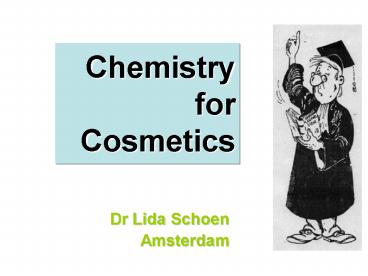Chemistry for Cosmetics PowerPoint PPT Presentation
1 / 46
Title: Chemistry for Cosmetics
1
ChemistryforCosmetics
- Dr Lida Schoen
- Amsterdam
2
Human skin
3
Dirt on the skin
- water soluble (sweat)
- oil soluble (sebum, grease)
- non soluble (sand, skin flakes).
- Rubbing with water and soap can remove all three.
4
Cleaning the skin water and soap
5
Washing dirt from textiles
with water and soap
6
Cosmetic cleaners
Showergel (shampoo)
7
Cosmetic emulsion
- Water
- Oil
- Emulsifier
- Additions
- Perfume
- Colour
8
Emulsion micro
9
Emulsion macro
10
Cream
- 2-3 emulsifier thickener (for stabilisation)
- 10 oil like
- mineral like paraffin (cheap, doesnt
deteriorate) - vegetable like avocado (whats good to eat )
- animal like mink (snob appeal)
- Water
- Perfume
- Additive, like
- dihydroxyacetone (artificial tanning)
- herbals
11
Flowers, herbals
12
Hair under microscope
13
Chemistry keratin
- Hydrogen bridges
- Ion-ion (salt) bonds
- Disulfide (sulpher) bonds
14
Keratin (2)
15
Keratin (3)
pH 5,5
16
Keratin (4)
cystin
17
All bonds (schematic)
18
(No Transcript)
19
Melanin in cortex
- Eumelanin
- black-brown
- large molecules
- easy to light up.
- Pheomelanin
- yellow-red
- smaller molecules
- difficult to light up.
20
(No Transcript)
21
Hair colour
22
Cleaning hair shampoo
- Detergent sodium lauryl (C12) ether sulphate
- cheap
- skin friendly
- good foam
- easy to thicken (with NaCl)
23
Ether sulfates
- Vegetable oil, after hydrolysation and reduction,
ethoxylation with ethylene oxide - Alkyl alcohol esterified with sulphuric acid
CH3-(CH2)10-CH2(OCH2CH2)nOSO3- Na with 1ltnlt4
24
Thickener electrolyte
- detergent in water micelles
- NaCl (3-4)
25
Conditioner in the past egg yolk
- Egg shampoo
- egg yolk lecithin
Conditioner today man made
- quat quaternary ammonium compound
- silicone
26
Hair in form 1775
today
27
Hair gel at school
- Carbomer (brand name in Europe) neutralised
cross linked polymer of acrylic (propene) acid - CH2CH-COO-Na
28
Bleaching (1)
- Decomposition of melanin by oxidation in alkaline
(ammonia) environment - carboxylated derivatives soluble at higher pHs.
29
Bleaching (2)
- Bleaching powder persulphate(O3S-O-O-SO3)2-
- 2 Na2S2O8 -gt 2 Na2S2O7 O2
- Hydrogen peroxide,(max. 12, pH 4), optimum
melanin bleaching at pH ? pKa (11,5) of the
peroxide-anion - In practice pH 10. H2O2(aq) 12 not stable at
pH 10.
30
Types of hair colouring
- permanent
- semi-permanent
- temporarily
- Oxidative
- Direct
31
Hair colouring products
- Natural
- Metal
- Permanent (synthetic dyes)
- Semi-permanent (natural en synthetic dyes)
- Temporarily (synthetic dyes)
32
(No Transcript)
33
(No Transcript)
34
walnut
henna
35
Semi-permanent hair colouring
- in and under cuticle
- 4-6 washings
- till 30 grey covering
36
Metal dyes
- Acetates or sulphates of lead, silver, iron,
copper, cobalt, bismuth, manganese, zinc - Sulphide bonds with sulphur from keratin
- Toxic properties!
- Sensitive to oxidation
37
Permanent hair colouring
- Oxidative dyes development with hydrogen
peroxide - Not washable
- Till 100 grey covering
38
Developers and couplers
Developers
couplers
39
Examples of couplings
40
Summary chemical trick
- Mix two (or more) types small molecules
- cover hair with mixture
- small molecules intrude the hair cortex (higher
pH will help to open cuticula) - inside the cortex small molecules react to form
bigger molecules - The big molecules are captured in the cortex,
they cant leave permanent hair dye
41
Bath salts
- Salt
- kitchen salt NaCl (cheap, crystals)
- soda Na2CO3 (softener)
- bicarbonate NaHCO3 (solubility)
- phosphate Na3PO4 (complexer)
- Perfume
- Colour (water soluble food colour)
- Extra (chamomile, herbals)
42
Perfume
- Natural (past) and synthetic (aldehydes, ketones,
esters) - Mixture of 3 groups notes
- Top
- Middle
- Base.
43
TOP
lime, lemon , mandarin, orange, grass,
apple, pineapple, cassis, raspberry, peach
citrus green fruity
MIDDLE
jasmin, rose, violet, muguet
floral
sandalwood, cedarwood, ambery, musky, vanilla,
sweet hay
BASE
woody powdery
44
Our Chanel Allure
- citrus 15 drops (top)
- lily of the valley 8 drops (top/ middle)
- rose 2 drops (middle)
- jasmin 10 drops (middle)
- floral bouquet 5 drops (middle)
- sensual 10 drops (base)
45
Dilution
- With min 70 alcohol
- Denaturised (tax reasons) with bergamot (citrus)
or DEP (di-ethylphtalate) - Perfume 20 oils
- Eau de Toilette 5 oils
46
Allure Fragrance Description
- From the Chanel website
- The concept of Allure was Coco Chanels ideal an
innocent seduction without artifice, an
unforgettable elegance transcending words and
conventions. - Fragrance family floral, fresh, oriental. A
faceted fragrance that mixes notes of the Orient
with abstract flowers. - A simple jewel that combines 6 complex facets. In
Allure, youll find bergamot, mandarin, water
lily magnolia, jasmine and may roses, vetiver
and finally, the velvety sensuality of vanilla.

